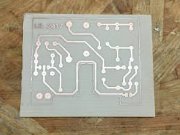HotSauce
New Around These Parts
- Joined
- Nov 6, 2020
- Messages
- 42
Hey folks,
For those who don't know me, I have a lot of fun 3D printing -
Recently I learned about a type of printer filament that's electrically conductive. The more affordable option is not really usable for audio electronics and other small signal amplifiers due to high volume resistivity of 30 ohm-cm. By comparison copper has a volume resistivity of just .00000172 ohm-cm. Oh well, these ideas would have to wait I guess...
But the other day I learned of another conductive filament:
https://www.multi3dllc.com/product/electrifi/
This one has a volume resistivity of just .006 ohm-cm - now we are talking! It's expensive, but the amount used per circuit would be so small that a single reel would probably last a long time. This would be a really good way of prototyping in a neat and clean way without having to change a lot of values when switching to an etched PCB. The weird part is you can't really solder to it in the same way - but that shouldn't be a big issue, you can reflow the filament itself with a soldering iron and apply a bit of silver paste or conductive epoxy to sure up the connection. This is still in the idea phase but if it worked it would be a great use of a 3D printer and a way to fabricate organized prototype circuits in a short time.
Anybody out there ever etched your own PCBs? How involved was that and do you think this process would have been useful to you? Would love to hear your thoughts.
Josh
For those who don't know me, I have a lot of fun 3D printing -
Recently I learned about a type of printer filament that's electrically conductive. The more affordable option is not really usable for audio electronics and other small signal amplifiers due to high volume resistivity of 30 ohm-cm. By comparison copper has a volume resistivity of just .00000172 ohm-cm. Oh well, these ideas would have to wait I guess...
But the other day I learned of another conductive filament:
https://www.multi3dllc.com/product/electrifi/
This one has a volume resistivity of just .006 ohm-cm - now we are talking! It's expensive, but the amount used per circuit would be so small that a single reel would probably last a long time. This would be a really good way of prototyping in a neat and clean way without having to change a lot of values when switching to an etched PCB. The weird part is you can't really solder to it in the same way - but that shouldn't be a big issue, you can reflow the filament itself with a soldering iron and apply a bit of silver paste or conductive epoxy to sure up the connection. This is still in the idea phase but if it worked it would be a great use of a 3D printer and a way to fabricate organized prototype circuits in a short time.
Anybody out there ever etched your own PCBs? How involved was that and do you think this process would have been useful to you? Would love to hear your thoughts.
Josh


